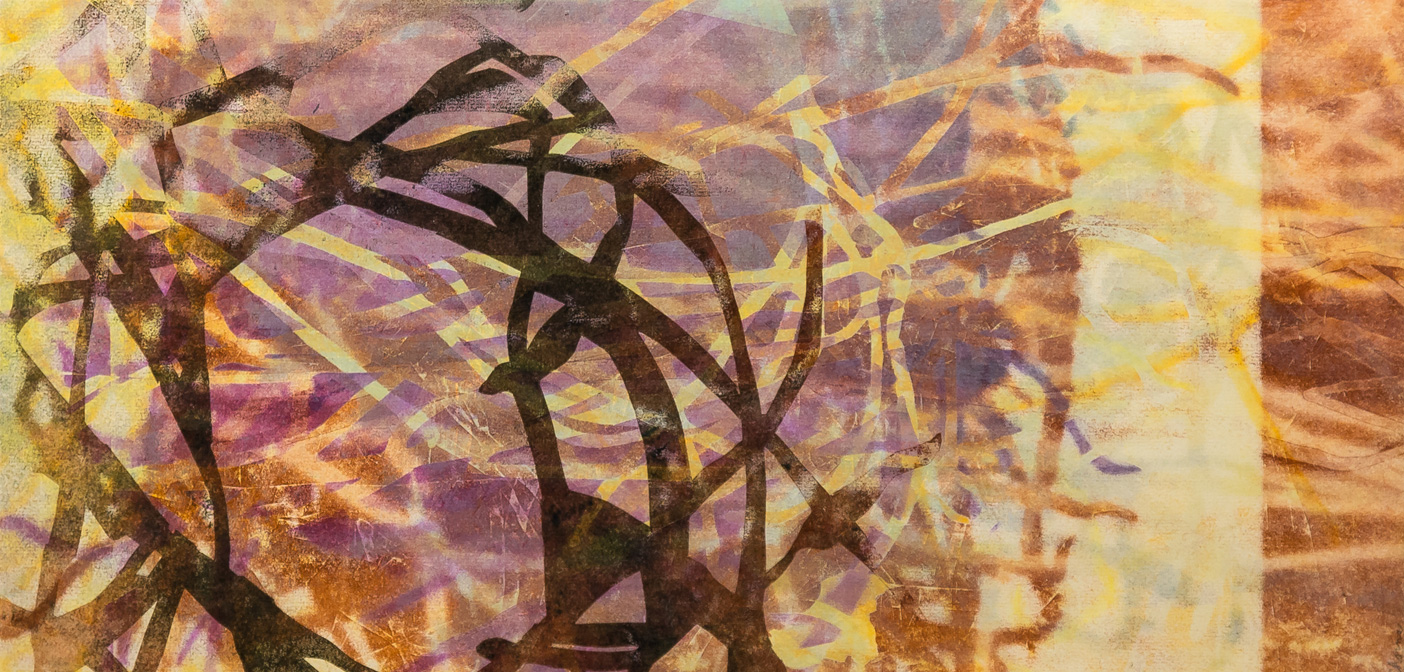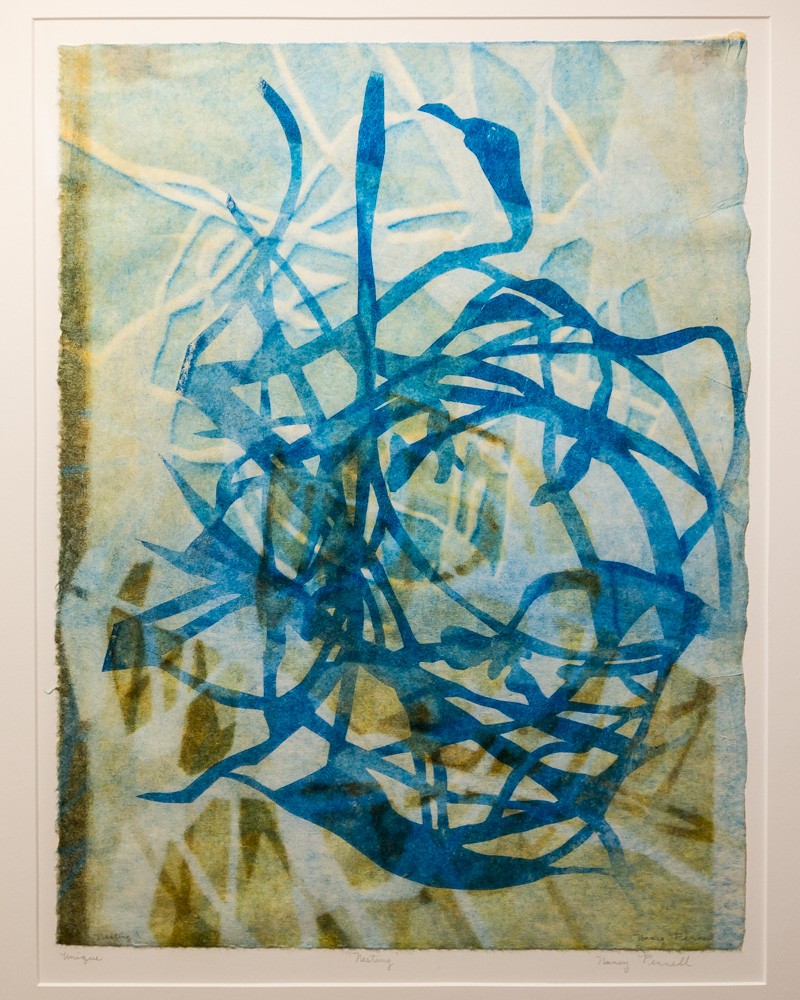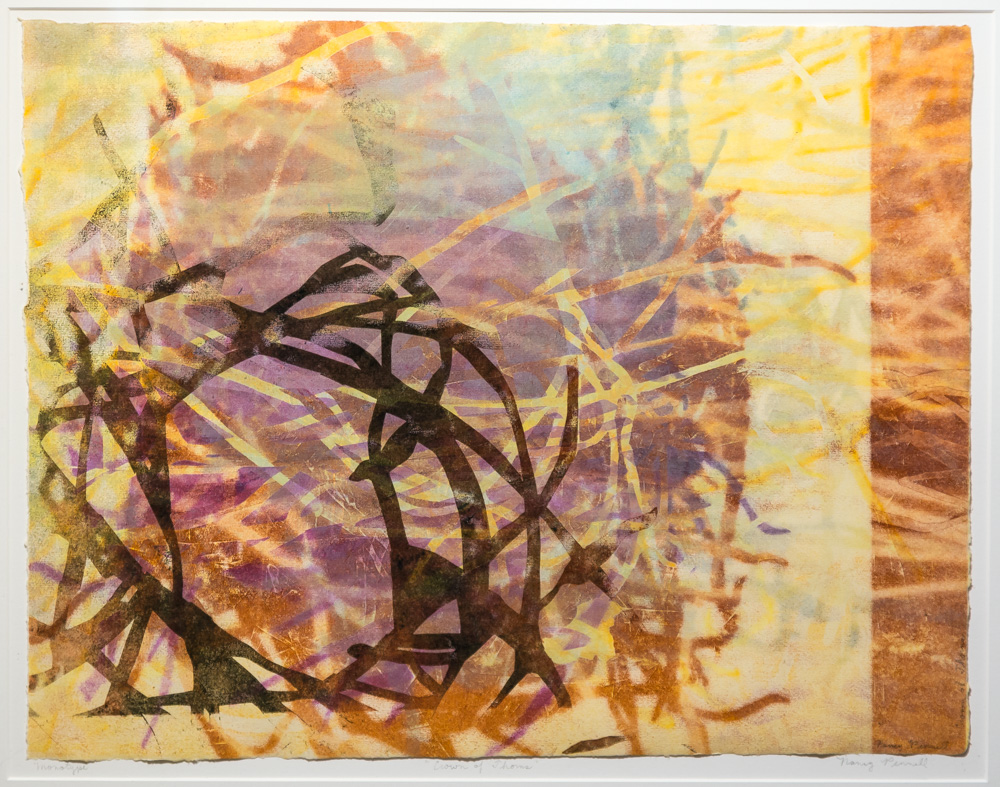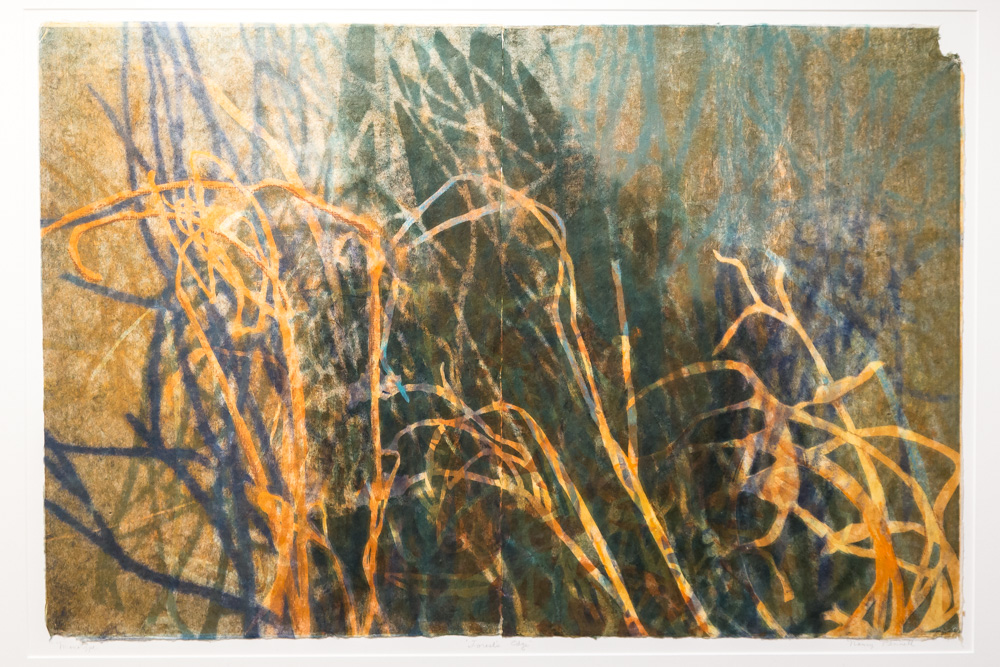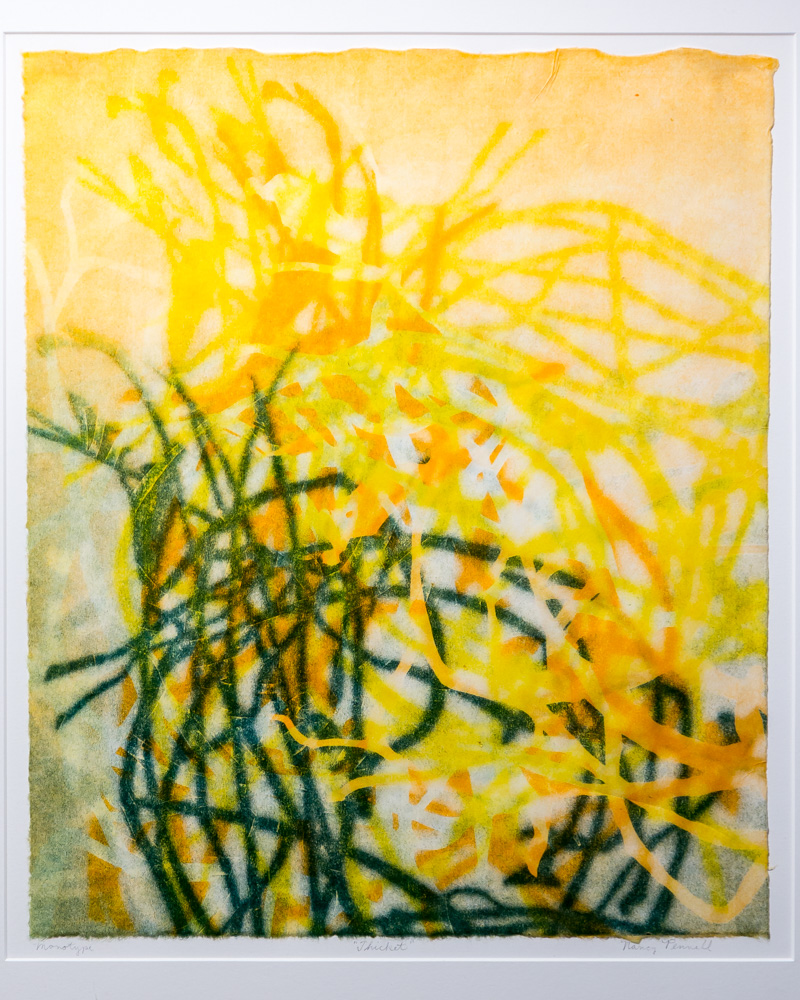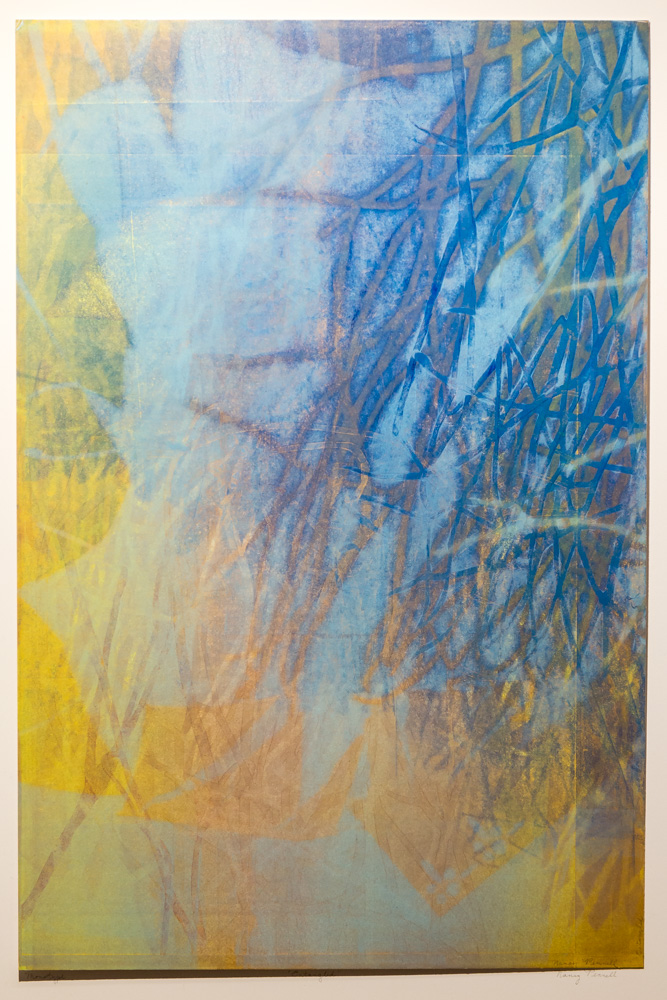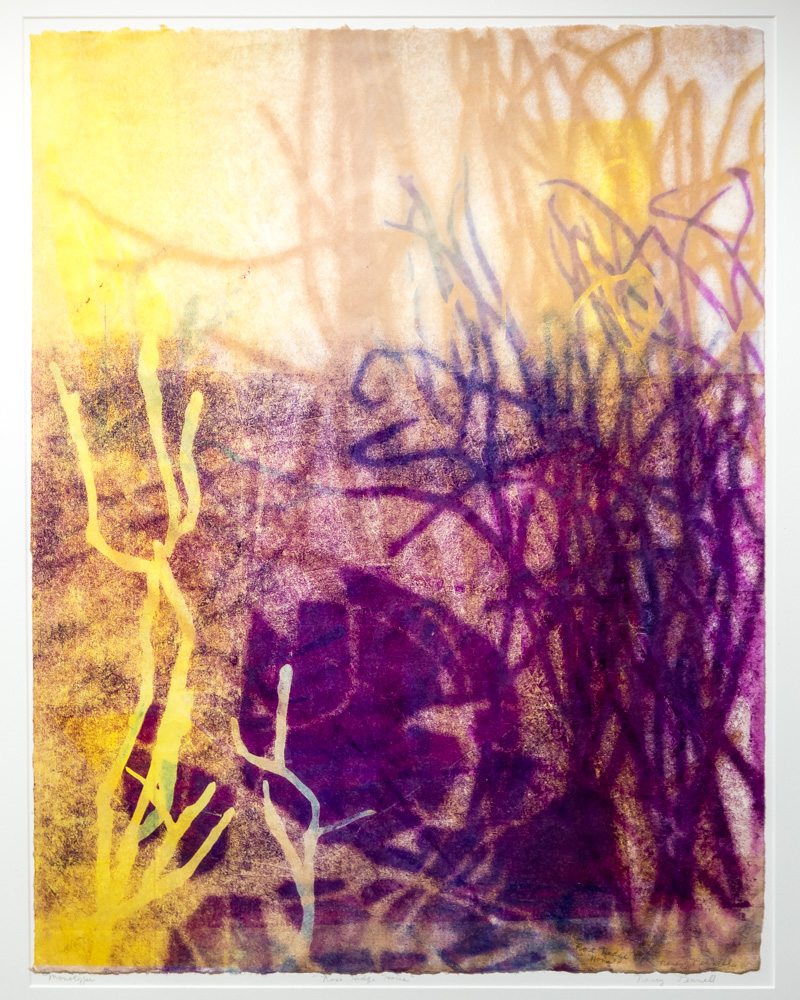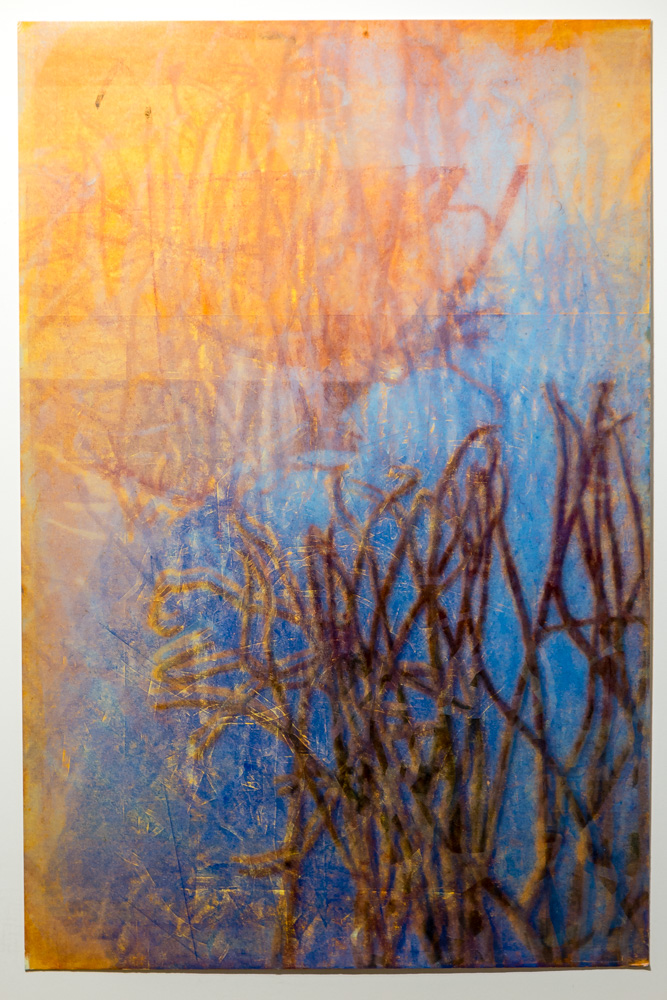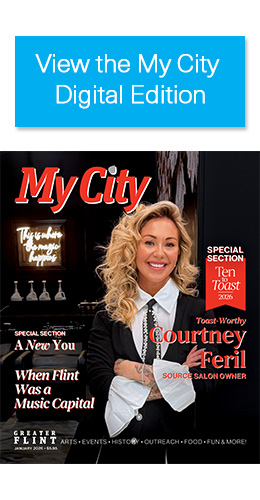Transcendental Depths,” a recent exhibit at Buckham Gallery, featured a series of nature-inspired prints by Nancy Pennell, 62, long-time member of Buckham Gallery and Flint Artists Market.
The series – a celebration of natural, wild habitats – began with a bulldozer and a torn-up hedgerow. She lives in the country, and had enjoyed watching deer meander through her property and cross the road to a calm river surrounded by untamed growth. She also marveled at the beauty of the overgrown hedgerow that once ran along her driveway between her home and her neighbor. Pennell watched birds build nests and rabbits make pathways through the plants and into their burrows and nests.
 But, one season, both of those natural spaces were altered and replaced with more tame, tidy land. She came home one day to a bulldozer knocking down the trees and greenery that surrounded the river. The deer stopped crossing. Not long after, the neighbors tore out the hedgerow. Her heart filled with sorrow over losing these natural areas, she began expressing her admiration of wild spaces through her work.
But, one season, both of those natural spaces were altered and replaced with more tame, tidy land. She came home one day to a bulldozer knocking down the trees and greenery that surrounded the river. The deer stopped crossing. Not long after, the neighbors tore out the hedgerow. Her heart filled with sorrow over losing these natural areas, she began expressing her admiration of wild spaces through her work.
The series of prints in “Transcendental Depths” was created in defense of the beauty of these overlooked spaces, Pennell asserts, “it’s nice to have weeds and growth. They have a purpose and I want others to see their beauty.” The prints have names like, “Bordering the Driveway” a tribute to the colors and edges of the missing hedgerow. Others include: “Nesting,” “Rose Hedge Home,” “Orange Grass,” “Lush Sanctuary” and “Thorny Offshoots,” giving a new-found appreciation to something that could be viewed as a nuisance. The prints take the viewer up-close with the natural, wild habitat, and create a more intimate relationship. This is in rather sharp contrast with the landscapes she painted previously. “I was always inspired by landscapes, but these are in the environment,” Pennell says, inviting the viewer to shift focus to the purpose and beauty that she sees. Moving from landscapes into her current work changes perspective from a vantage point where overgrown or small natural spaces can be thought of as insignificant. This work focuses on the important refuge they offer for wildlife, and for Pennell, as well.
Pennell received an MFA from Michigan State University and has been an artist her whole life. She says, “My father was a commercial artist and I remember him painting, and my mother was very artistic, too, so we would sketch and paint. I took art classes in high school but it wasn’t until I was in college that I got a little more serious about it and about learning more techniques.” Art was something that she grew with and grew into, always continuing her training as well as experimenting with new media. For Pennell, it was a gradual thing, as she took additional classes while raising two children. She has created with oil painting, water color, pastel, and then found printmaking. She says, “I keep trying different things; but the last ten or 15 years, I’ve focused on printmaking.” This has led her to several workshops, conferences and classes around the country – even presenting her own workshop on printmaking at MSU this past spring.
All of the prints in this series were made on the presses at Mott Community College (MCC). Pennell explains, “I had the opportunity to take printmaking classes at MCC and that really brought me back into it again, because they have the presses there and lots of equipment that I don’t have the room for.” MCC offers four different levels of printmaking courses, and she has worked with the likes of Sam Morello (founding member of Buckham) and Mike Sevick, (who now teaches at UM-Flint), among others. When they aren’t offering the class, Pennell takes a “special projects” course, which allows her to continue working in the studio.
She has been greatly influenced by the workshops and printmaking conventions she attends, specifically the work of well-known printmaker Karen Kunc, and Jean Gumpper, who had a workshop at MCC. The international printmaking conventions, Pennell says, “have between 1,500-2,000 printmakers, as well as demonstrations and discussions, and one of the demonstrations was where I learned to start incorporating the laser printer and stencils into my work.”
Her work usually begins with a drawing. She sketches a design, scans it, and then modifies it on the computer so it can work on the laser printer. Then, those pieces get cut and used as stencils. “I cut two different types of stencils – one out of matboard that has some thickness, and the other is cut out of a sheet of Mylar which is very thin,” she explains. This allows her to create the layering element her prints have. An additional layer is part of many of Pennell’s prints, she says, “on top, sometimes I will place the Mylar, so the stencil underneath won’t print because the Mylar blocks it – that is what gives hard edges to the prints. The soft edges are the stencils diffused from underneath and the hard edge is the stencil on top, and you will usually see both.” Her pieces go through this process several times, once for every layer of color. “I start with maybe a yellow, and then orange and then green, and usually use the same board to roll my ink onto,” and that is an important part of her new exploration because she says, “things start happening on the board – sometimes, I end up liking my boards.” In fact, the “Transcendental Depths” exhibit included two large pieces that were boards she rolled ink onto that created an unpredictable “found art,” which she warmly embraces.
Pennell’s connection to the wild spaces found in nature seems to flow into her experiences with her artwork. She views every space as one that can surprise you with beauty. She is also enjoying experimentation with smaller pieces of paper. “I have a lot of small scraps and instead of wasting them, I’m using all of the ink on the board for different pieces, and I come out with some nice, really small pieces.” All in the name of not wasting potential sources of beauty.
As she continues to experiment, Pennell plans to create a series of prints based on her observations of the way ink bleeds through the paper during printing. “Sometimes, I like what happens on the other side of the paper. I want to make a piece where both sides of the print can be shown – that they each have their own thing that works, and then I could suspend it from the ceiling so that it is free-flowing,” she smiles. Pennell also has plans to continue working with Japanese handmade scroll paper. One print in the “Transcendental Depths” series, “Fleeting Glimpse of Fallen Trees,” is made with three long sheets of the scroll paper that she monoprints onto plexiglass and runs it through the press several times.
No matter the direction, Pennell is surely continuing her play, experimentation and celebration of natural beauty through her art. To find out more, visit buckhamgallery.org.
Photography by Eric Dutro











